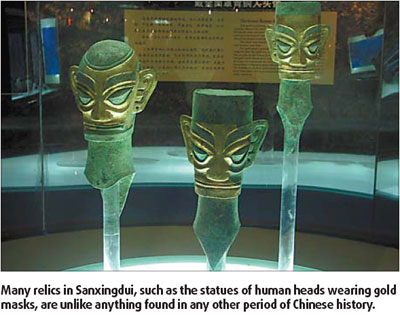|
The UFO Files Ancient Aliens |
||
|
..
Aliens or
ancestors? The mysteries of ancient Sichuan
One of the more impressive displays at the Sanxingdui Museum, in Guanghan of Southwest China's Sichuan Province, is a bronze statue of a barefoot man with anklets and clenched hands. The 2.62-meter-high, 180-kilogram statue is thought to represent a king of the Shu Kingdom. Shu was the name for Sichuan in ancient times. Dating back 3,100 years, the king's statue is crowned with a sun motif and coated with three layers of tight, short sleeved bronze "clothing", which is decorated with a dragon pattern and overlaid with a checked ribbon. Huang Nengfu, a professor of arts and design at Tsinghua University and an eminent researcher in Chinese clothing from different dynasties, considers the garment to be the country's oldest existing dragon robe. He also thinks that the pattern is the work of the famous Shu Embroidery. The robe has changed the traditional view that Shu Embroidery began in the mid-Qing Dynasty (1644-1911). Instead, it shows Shu Embroidery appeared in the Shang Dynasty (c.16th century-c.11th century BC), according to Wang Yuqing, a Taiwan-based Chinese clothing historian. The bronze statue of the Shu king is one of the four most important cultural relics to be found in the Sanxingdui Ruins in Guanghan, a city 40 kilometers from Chengdu.
Sanxingdui, which means "three star mounds" in English, is so named because the ruins are located in a village where there are three mounds. Since 1929, more than 10,000 relics, dating between 5,000 and 3,000 years ago have been unearthed in the city's Sanxingdui Ruins. The excavations have yielded some of the most significant Chinese archaeological discoveries of the 20th century. Archaeologists around the world were excited by the unearthing of large palatial remains in 1980, the remnants of eastern, western and southern walls in 1984 and the discovery of two large sacrificial pits in 1986. These discoveries proved that Sanxingdui contains the ruins of an ancient city that was the political, economic and cultural center of the ancient Shu Kingdom. A metropolis of its time, Sanxingdui boasted highly developed agricultural and mining systems, and produced ceramics and sacrificial tools. Before the excavation of Sanxingdui, it was believed that Sichuan had a history dating back 3,000 years. Thanks to the excavation, it is now believed that civilized culture first appeared in Sichuan 5,000 years ago. Source: China.org.cn/english/culture/ See Also: Aliens of Ancient China |
||
| FAIR USE NOTICE: This page contains copyrighted material the use of which has not been specifically authorized by the copyright owner. Pegasus Research Consortium distributes this material without profit to those who have expressed a prior interest in receiving the included information for research and educational purposes. We believe this constitutes a fair use of any such copyrighted material as provided for in 17 U.S.C § 107. If you wish to use copyrighted material from this site for purposes of your own that go beyond fair use, you must obtain permission from the copyright owner. | ||
|
|


